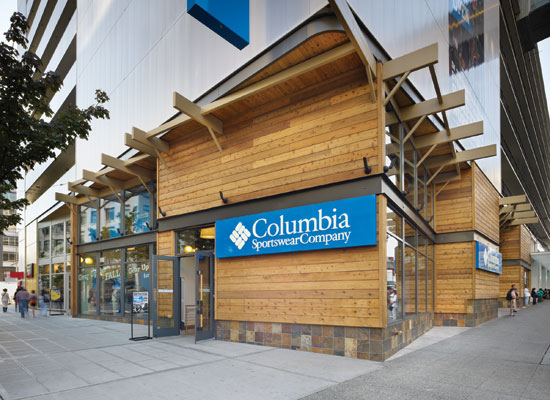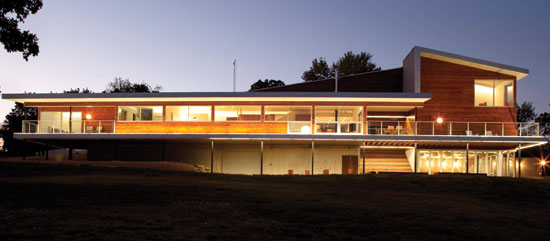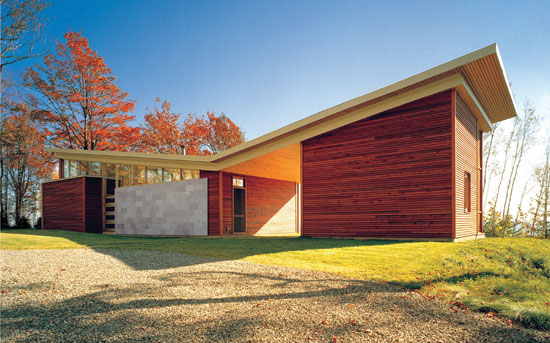Growing Bolder: Specifying Western Red Cedar for Architectural Applications
Grades as well as standards for the wood species are defined and promulgated by the National Lumber Grades Authority (NLGA), West Coast Lumber Inspection Bureau (WCLIB), and Western Wood Products Association (WWPA) in addition to WRCLA producer standards. Several are suitable for siding and trim, one of the most common architectural uses of Western Red Cedar, says Paul Mackie, a technical specialist and field representative for the lumber association. For example, bevel siding—the most widely used kind, in which the lumber is resawn at an angle to create a thicker edge and a more slender edge—is offered on the following categories:
▶ Clear Vertical Grain (VG) Heart. The highest grade for bevel siding, all clear VG heart grade is sawn vertical grain, also known as edge grain, and kiln dried. The smooth faces should be free from any “growth characteristics” that could impact performance or look, says Mackie, so they hold finishes well and exhibit the best dimensional stability.
▶ A Clear. This is also a fine grade meant for consistent appearance, though it allows more growth characteristics in pieces of mixed grain—both vertical and flat. They may be sold along with B grade pieces of cedar.
▶ Clear Rustic (also called Clear Tex). Where a more rustic or saw-textured appearance is desired, the rustic grade may be suitable, with its limited growth characteristics that offer a distinctive look but do not detract from serviceability.
Clear Vertical Grain and A Clear bevel siding are graded for smooth face applications but are generally also reversible to the resawn face.
On the other hand, some designs call for the special look of knotty Western Red Cedar, which adds warmth and impact as a bevel siding or trim product. The look is essential to the Lobster Boat House project, which blends the wood with reinforced acrylic sheets and fiber cement panels to “celebrate its location” on a dense urban shoreline site. In addition to reusing an existing floor and basement foundation, the building employs materials and systems “based on low monetary, environmental, and life-cycle costs.”

Photo by Benjamin Benschneider, courtesy of WRCLA
The signature retail spaces for Columbia Sportswear Company and subsidiary brand Mountain Hardwear created a storefront of knotty Western Red Cedar leading into nearly 20,000 square feet of retail space on a highly visible corner in Seattle.
In this way, knotty cedar has earned a reputation as a value specification, though it is seen in high-end building projects including country clubs, resorts, and high-visibility commercial settings. In these applications, two kinds of knotty grades are used for siding:
▶ Select Knotty. As expected, this grade has knots and other natural features, though the knots must be sound and tight. In occasional cases, the siding boards may be prepared with knots glued on the reverse face. It may also be sold with a percentage of Quality Knotty grade. (NLGA 205b/WCLIB 111-f)
▶ Architect Knotty. This product is designed for siding detailed with the resawn face exposed, after trimming, to fit the needed stud wall spacing or other substrate conditions. These boards have no open areas or through defects, and adhesives may be used, in a small number of cases, on the reverse face to secure knots. This is a good, kiln-dried grade for factory priming or finishing.

Photo by Hufft Projects and WRCLA
The architecture team at Hufft Projects specified sustainable Grade A clear and Select Knotty grades of Western Red Cedar and a monumental aluminum shed roof, all elevated on steel columns.
Other types of siding call for different grades and wood standards. For example, the vertically articulated board-and-batten claddings are typically made with rough-sawn, kiln-dried wood or boards surfaced on one side and two edges. On the other hand, lap sidings with shadow line effects, such as channel siding—whether installed vertically, horizontally, or diagonally—can use knotty grades including Select Knotty or A Clear-type pieces. Other siding profiles can be seasoned or unseasoned and can be clear or knotty grades, but in general, specialists will rarely recommend diagonally applied sidings. The claddings should be kiln-dried for best results. Lap siding types may also be specified as:
▶ Clear Heart, the highest grade for clear Western Red Cedar. This grade includes only pieces with heartwood on the exposed face. Some pieces may have minor imperfections, but overall the grade ensures a fine, consistent appearance.
Trim boards are another common architectural application, and grades and textures for Western Red Cedar boards have been developed to serve this niche, including both clear and knotty varieties.

Photo by Marc Cramer, courtesy of WRCLA
Using a mix of stone, wood, and glass, the firm Affleck de la Riva Architects designed the Minton Hill House in Québec using knotty grades of Western Red Cedar.
Enhancing the design flexibility, the boards can be textured as rough, surfaced on one side, two edges and surfaced on four sides. If knotty is preferred, the best grades to choose are Select Knotty and other proprietary or in-house grades determined suitable by the producer. Where clear Western Red Cedar is desired for kiln-dried finish lumber, Clear Heart and A Clear grades are typically used. Two additional grades are available for trim made of unseasoned or seasoned clear grades:
▶ C and Better Clear. This is high-quality lumber for use where appearance is important, used both as trims and for cabinetry, doors, windows, and the like.
▶ D Clear. For general utility and cost savings, this grade may be allowed. It permits larger and more numerous natural visual characteristics. Cross-cutting may be necessary to achieve the best results for this grade.
For trim boards and for some kinds of siding, there are also proprietary grades—a term that means the wood is designed to meet the appearance requirements given by the architect and defined, agreed, and “graded” by the producer. In this case, the architect and project team should work with the manufacturer to understand the specifications written in terms of nomenclature and visual results.









